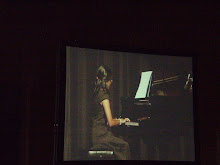Shine is a 1996 Australian film based on the life of pianist David Helfgott, who suffered a mental breakdown and spent years in institutions. It stars Geoffrey Rush, Lynn Redgrave, Armin Mueller-Stahl, Noah Taylor, John Gielgud, Googie Withers, Justin Braine, Sonia Todd, Nicholas Bell, Chris Haywood and Alex Rafalowicz. The screenplay was written by Jan Sardi, and Scott Hicks directed the film. The degree to which the film's plot reflects the true story of Helfgott's life is disputed (see below). The film made its US premiere at the Sundance Film Festival. Geoffrey Rush was awarded the Academy Award for Best Actor in 1996 for his performance in the lead role.
Plot
As the film opens, a man (Geoffrey Rush) wanders through a heavy rainstorm finding his way into a restaurant. The restaurant's owner tries to determine if he needs help. Despite his manic mode of speech being difficult to understand, she learns that his name is David Helfgott and that he is staying at a local hotel. She returns him to the hotel and despite his attempts to engage her with his musical knowledge and ownership of various musical scores, she leaves.
In a flashback to David's childhood (played by Alex Rafalowicz), he is competing in a local music competition. Helfgott has been taught to play by his father, Peter (played by Armin Mueller-Stahl), a man obsessed with winning who has no tolerance for failure or disobedience. David is noticed by Mr. Rosen, a local pianist who, after an initial conflict with Peter, takes over David's musical instruction.
As a teenager, David (played by Noah Taylor) wins the state musical championship and is invited to study in America. Although plans are made to raise money to send David and his family is initially supportive, Peter eventually forbids David to leave, thinking this will destroy the family. Crushed, David continues to study and befriends local novelist and co-founder of the Communist Party of Australia, Katharine Susannah Prichard (Googie Withers). David's talent grows until he is offered a scholarship to the Royal College of Music in London, England. David's father again forbids him to go but with the encouragement of Katharine, David leaves and is disowned by his father.
In London, David enters a Concerto competition, choosing to play Rachmaninoff's difficult 3rd Concerto, a piece he had attempted to learn as a young child to make his father proud. As David practises, he increasingly becomes manic in his behaviour. David wins the competition, but suffers a mental breakdown and is admitted to a psychiatric hospital, where he receives electric shock therapy.
David recovers to the point where he is able to return to Australia, but is still rejected by his father. David relapses and is readmitted to a mental institution as a young man. Years later, a volunteer at the institution recognizes David and knows of his musical talent. She takes him home but discovers that he is difficult to control, unintentionally destructive, and needs more care than she can offer. She leaves him at the hotel from earlier in the film. David has difficulty adjusting to life outside the institution, and often wanders away from the hotel. At this point, the film resumes chronologically with David wandering to the nearby restaurant.
The next day David returns to the restaurant, and the patrons are astounded by his ability to play the piano. One of the owners befriends David and looks after him. In return David plays at the restaurant. Through the owner David is introduced to Gillian (Lynn Redgrave). David and Gillian fall in love and marry. With Gillian's help and support, David is able to come to terms with his father's death and to stage a well-received comeback concert presaging his return to professional music.















